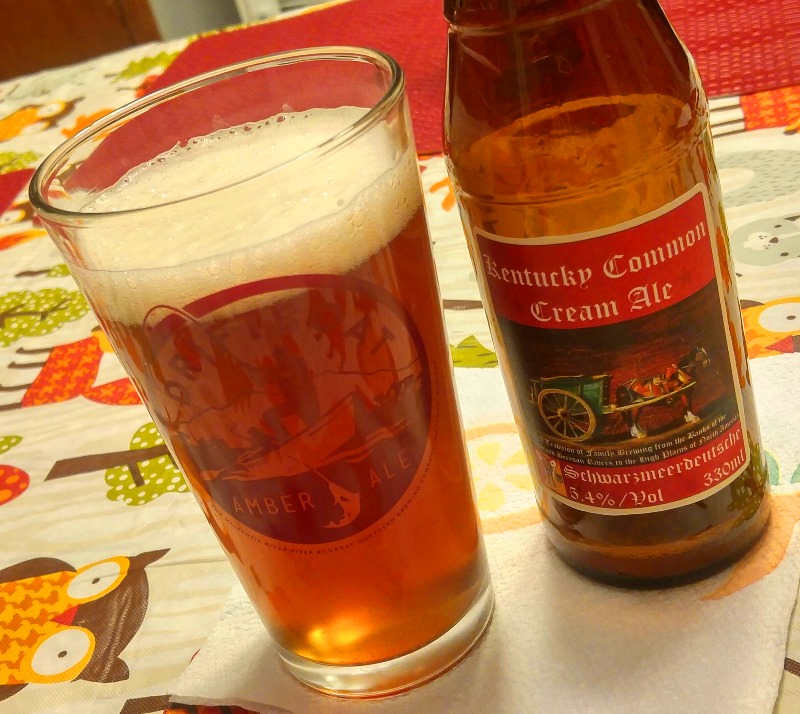@MonkeyBot and @Turbo26 ; I finally brewed this beer!
The thread and running discussion (along with a LOT of ADD moments while I sort out the ingredients and hops) can be found here:
https://www.homebrewtalk.com/showthread.php?t=583757
To summarise, I went with what seemed to me to be a good, solid representation of the original, trying to strike the best balance between historical accuracy and my current equipment and skills. I did, in the end, elect to use the flaked corn, rather than do a cereal mash, but I think I can be forgiven for that.
I brewed this last night, and I think it's going to be a good one ~ here's a report on the brew itself:
The brew went off with no significant hitches that I can recall; my #2 son, Mike (known here as @mtbrewer403 ) gave me a hand, and we had a pretty good time, I think. He's an IPA guy, so he was pretty amused by my modest use of hops, but it's all good. He showed me a couple of things that he does when he's brewing, and they looked like pretty good tips to me, so I will be using them in the future.
Mash - I was able to keep the temperatures fairly close to where I wanted them - and it smelled great! The flaked corn added a nice touch, I think.
Sparge - No sticking issues, no spills - everything went fine.
Boil - I went with the slightly-modified hop schedule (below) for lower IBUs as the maltiness (bordering on sweetness) was mentioned prominently in the research; everything went fine and on schedule. The Cluster hops smelled really good with this, and the Hallertau Mittelfrüh added a nice touch, as well. I was actually tempted to add a little more hops at all stages, but for this first one, I left things alone.
Chill-down - once again, no hitches. I have never used Irish moss before, but I definitely plan to use it more often, after this experience; it really pulls the crud down, it seems.
Transfer to fermenter and pitching the yeast - no troubles at all; I only had to top off with a very small amount of water - I'd say less than a quarter-cup.
The only irregularity of note was that the wort/beer was slightly darker than expected, in spite of the very, very small amount of black malt and C60. Where these dark malts are concerned, it doesn't take much! The darker colour could also have something to do with my water; I've noticed that all my brews, no matter what style and no matter what conditions, are always just a bit darker than I expect them to be. No big deal, as they all taste great.
I checked in on my beer this morning, and the S05 is definitely doing it's thing; slow and steady, which matches my experience with it so far. There is a nice cap of krausen developing, and I am sure that by the time I get home from work, it will be churning up for a good, solid fermentation and the blow-off tube will be getting busy. The ambient temperatures are just a few degrees higher than I would prefer, but we still seem to be well within the tolerance of this yeast. The next few days will be cooler, and this will help. Considering that we have been consistently above 90 since the end of June and are finally seeing some relief, I am not going to complain.
Here is the final recipe that was actually brewed; if anyone is following my brain-storming, ADD-infested, rambling development, please disregard all others, for now:
Kentucky Common Ale
TasunkaWitko's Adaptation
All-Grain
1 Gallon
OG - 1.051
FG - 1.010
ABV - 5.44%
IBUs - 24.08
SRM - 11.58
Fermentables:
19.22 ounces American 6-Row Pale Malt (60%)
11.84 ounces American Flaked Corn (37%)
0.5 ounces American Black Malt (1.6%)
0.45 ounces American Caramel/Crystal 60L Malt (1.4%)
60-Minute Mash @ 154 degrees
60-minute boil
Hops:
1.5 grams Cluster (7.6% AA) @ 60 minutes
1.5 grams Cluster (7.6% AA) @ 45 minutes
3.0 grams Cluster (7.6% AA) @ 15 minutes
1.5 grams Hallertau Mittelfrüh (3.75%) @ Knock-out
Other Ingredients:
Irish Moss - 0.4 grams @ 15 minutes
Yeast
Safale US-05
Also, here is the label that I came up with for this beer:

That's what I have for now; I will post more as it happens, on the thread linked above....
Ron





